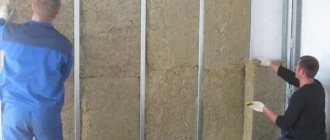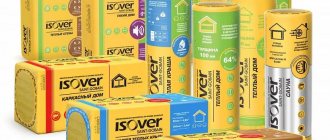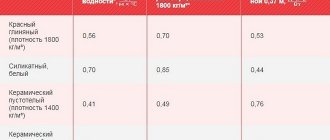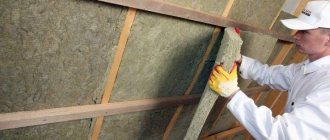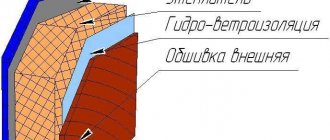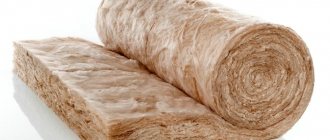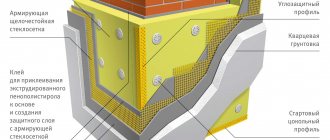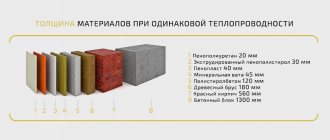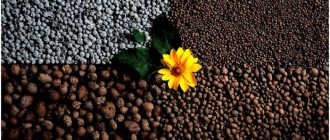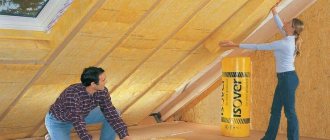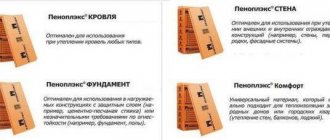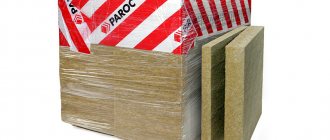The current range of basalt insulation materials includes several dozen varieties that are in consistently high demand in cottage and country house construction. Ecologically impeccable basalt thermal insulation can be used for interior and exterior decoration of walls and ceilings. In this case, the loads created by the weight of the material are taken into account. What density of basalt insulation should be preferred?
The density of the insulation determines its weight, and, accordingly, the level of additional loads on the insulated structures. The lack of the required safety margin is compensated by the use of lighter heat insulators.
Roof thermal insulation
- For work on insulating roofing systems, a number of basalt insulation materials with a density of 37 kg/m 3 or more
. - In addition to heat preservation, lightweight basalt wool has effective noise absorption and stable performance characteristics throughout its half-century service life. The material does not tolerate deformation loads well. In a compressed state, its thermal conductivity increases significantly.
- There are exceptions: certain types of light insulation are supplied to the retail chain in a 60% pressed state. After opening the packaging shell, the material is completely restored to its original volume with full preservation of its working properties.
Basalt wool and mice
Mice were “domesticated” probably tens of thousands of years ago, when humanity settled down and took up farming. Since then, the fight against them has not stopped. And today the “final solution” has not yet been found .
Of course, it would be great if the insulation killed rodents, but they are also warm-blooded, and what is harmful to them can be harmful to humans . Therefore, there is no poisonous basalt wool for mice.
Do mice live in basalt wool?
Second question: can basalt wool repel rodents and be uncomfortable for them?
Let's start with the fact that , of course, it is not suitable for them as food , but they gnaw not only food, but also materials in which they are going to make passages and make a burrow. Therefore, the inedibility of cotton wool is not an argument that it will not be chewed.
Do mice live in basalt wool? This is how they live - they build tunnels, make nests and reproduce. It is quite suitable for nests ; by the way, it is warm and not prickly.
But if you think that prickly glass wool is a problem for mice, then the experience of rural residents refutes this assumption. Even in the prickly glass wool, mice manage to gnaw passages.
They are not afraid of the phenol-formaldehyde binder, which almost all types of mineral wool contain.
In general, you should not hope that basalt wool will somehow protect you from mice . You will have to protect yourself using the usual methods - putting nets on the ventilation holes, getting cats... But the most important factor for the disappearance of mice has always been and remains either the lack of food in the house , or storing it in a place inaccessible to rodents. (But the presence of products within walking distance, that is, in a neighboring house or store, can negate your efforts to remove mice.)
What is the density of wall insulation?
Thermal insulation of walls can be: panel or roll. The choice of the type of material for facade thermal insulation work is determined by the type of fastening and the presence of protective and decorative cladding. The density of wall insulation is in the range of 110-140 kg/m 3
.
Less dense material on vertical walls can deform and sag under its own weight.
of 90-140 kg/m3 have been developed for hanging and panel-plaster facade insulation systems
. The peculiarity of these materials is that the soft back surface of the panel closely copies the microrelief of the base. While the dense front retains its original shape and absorbs the loads from the plaster coating
Have questions? Call the number
8
Head of Sales Department
In suspended heat-insulating facades equipped with a slotted ventilation gap, dense insulation makes it possible to exclude windproof film coverings from the structure.
The increased density of facade thermal insulation allows the use of combined adhesive and dowel installation. The texture of the panels ensures good adhesion to plaster coatings.
- Hydrophobization does not allow the insulation to retain a large amount of moisture in its volume. In the best models this figure is 1.2-1.5%.
- Thermal insulation technologies provide for the installation of membrane or any other waterproofing that protects against leaks or the formation of water condensation.
High-density mineral wool insulation is designed for use under heavy loads. Heavy, dense panels are part of flat roofing systems. Used for insulation of concrete screeds and loaded building structures.
Does basalt wool burn or not?
Combustion is a process of fairly rapid oxidation with oxygen , with the formation of oxides, of course. But here’s what’s interesting: if you look at the chemical composition of the same basalt, it seems to consist of only oxides. Where should it oxidize next?
Well, in fact, of course, not entirely so, we forget that basalt wool is not only basalt, but also the resins used to glue the fibers, therefore, there is still something to burn in it.
The videos often show how a hole is made in a mat using a torch in a matter of seconds, and its edges char and melt.
Pay attention to the density of the mat. Now look: the lower the density, the less stone per unit area, right? And if the melting temperature is reached, then the thin threads shrink, turning into drops of much smaller volume than cotton wool . Holes in a low-density mat are caused by shrinking fibers, and fumes are caused by burning out glue.
If the density of the mat is high, for example, 140 kg/sq.m, then the result of the fire will be like this:
So, if you ask the question bluntly, whether basalt wool burns or not, the answer must be that it does not burn. There is simply nothing to burn in it except glue. But the prolonged action of the flame melts the fibers, the cotton wool turns into small balls and the volume disappears. The lower the density, the more noticeable the reduction in volume.
Here is another video where cotton wool is soaked in gasoline ( the combustion temperature of gasoline is 800-900 degrees ), and there is definitely something to burn, and then the cotton base is sawn, see the result for yourself:
What temperature can basalt wool withstand?
It is logical that the temperature that basalt wool can withstand is the melting point of the source materials. And it varies within certain limits, depending on the raw materials used. If you watch the first video carefully, you can see the temperatures in the melting zone. They are no higher than 1150 degrees. This is normal for basalt. It happens that a stone with a different melting point is used as a raw material, but it will still not be higher than 1400 .
Why does glass wool “burn”? Because ordinary glass melts at a temperature of around 500 degrees. Different types of mineral wool have different melting temperatures of the starting materials. If you want to be sure of the ingredients, take only products with certificates.
Is basalt wool non-flammable or fire-resistant?
Let's assume that the maximum that may interest us is the fire temperature. We looked at the data. For interior spaces, figures of 800-900 degrees are given. outside , so for solids the combustion temperature can be 1000-1250 degrees, for liquids - 1100-1300 degrees, for gases - 1200-1350 degrees.
Basalt wool in the form of a slab. Photo by Leroy Merlin
You see that indoors basalt wool can be considered non-flammable or fireproof , but outside... it depends on the raw materials and density of the mat. Of course, we are talking only about melting and changing the volume of cotton wool, but not about combustion or its maintenance. The fact that they are impossible for already oxidized substances was stated above.
Table of density and other characteristics of basalt insulation
| Product type | Density | Thermal conductivity | Limit temperatures, ͦС | Flammability |
| Mats | 50–85 | 0,046 | +700 | NG |
| Light slabs | 30–40 | 0,036 | +400 | NG |
| Soft slabs | 50–75 | 0,036 | +400 | NG |
| Semi-rigid slabs | 75–125 | 0,0326 | +400 | NG |
| Rigid slabs | 175–225 | 0,043 | +400 | NG |
| Cylinders | 200 | 0,046 | +400 | NG |
| Loose cotton wool | 30 | 0,050 | +600 | NG |
Area of use of basalt insulation
The scope of application of the material is quite extensive. It is used to insulate houses, apartments and industrial facilities, and the choice of insulation type is determined by the intended purpose of the slabs.
Density determines not only the choice of material, but also the specific intended purpose. For this material, this indicator is the main parameter when choosing the appropriate brand.
Stone wool is used in municipal services, shipbuilding and industry for insulation of a wide variety of objects.
Also, different types of basalt wool are used for external and internal insulation of residential buildings and premises.
Why is it so important to maintain the vapor permeability of insulated structures?
Regardless of density, basalt insulation has good vapor permeability. The transition of the dew point to the volume of thermal insulation provides walls and ceilings with more comfortable operating conditions. For complete and timely removal of moisture, ventilated structures such as curtain walls or vapor-permeable plaster coatings are used.
Blocking natural vapor and gas exchange in the walls can have negative consequences, including worsening the microclimate in the house and reducing the living comfort of its inhabitants.
We will help you choose and buy building materials correctly, and a team of true professionals will provide construction services in the shortest possible time and at an affordable cost!
Basalt wool: characteristics and properties
Let's move on to quantitative indicators of the physical properties of basalt wool.
Fire-retardant basalt sheet 1200x500x5mm. Photo by Maxidom
Density of basalt wool
The density of a fibrous material depends on the number of fibers per unit volume. The fewer there are, the more air there is, so the density of basalt wool differs significantly from the density of the stone from which it is made.
So, density is mass divided by the volume it occupies. Each package of basalt wool should have a value for its density.
Please note that the density does not depend in any way on the thickness of the insulation. It is the same for both 50 and 100 mm.
On sale you can find basalt wool with a density from 30 kg/cub.m to 185 kg/cub.m. In principle, each manufacturer has its own line of densities.
The least dense wool is the most easily affected by fire, do you remember this?
Burning temperature of basalt wool
We have already explained above that mineral wool does not burn in the literal sense of the word, that is, it does not oxidize (except for the binder), therefore the “burning temperature of basalt wool” is “its melting temperature.”
Melting point of basalt wool
But this is already correct. The melting point of basalt wool is equal to the melting point of the stone used for its manufacture. If it is basalt, then it is equal to 1100-1250 degrees.
Insulation Rockwool Standard 50 mm. Photo by Leroy Merlin
However, keep in mind that fine fibers are easier to melt than a solid piece of stone. Simply put, it’s not a decrease in temperature, but the speed at which it is reached.
In the video above, we saw that the pyrometer showed exactly the numbers that approximately correspond to the declared ones. The difference can be attributed to measurement errors.
Thermal conductivity coefficient of basalt wool
A little physics. Different materials heat up at different rates. The difference lies in the thermal conductivity of the materials.
To find out this quantitative characteristic, an experiment is carried out in which a sample of material having a unit area (1 sq.m) and a unit length (1 m) is heated on one side 1 kelvin more than on the other. The amount of heat that passes from the hotter side to the colder side is measured. The result obtained is called the thermal conductivity coefficient.
Keep in mind that this value does not depend in any way on the thickness of the layer.
The thermal conductivity coefficient of basalt wool is 0.045-0.055 W/(m*K). Rockwool 0.042-0.046 for its products . “Isover” is respectively 0.032-0.044 W/(m*K).
What does the thermal conductivity of wool depend on? From the relationship between the thermal conductivity of air and stone fibers. The more air there is between the fibers, the closer we are to the thermal conductivity values of air, and vice versa.
What role does layer thickness play in this? The lower the thermal conductivity, the thinner the thermal insulation layer will be needed.
Influence of insulation density on performance characteristics
To insulate a room from the outside or inside, an important indicator is the density of the material.
Density affects the following parameters of the material used for wall insulation:
- declared thermal insulation properties;
- quality of sound insulation;
- resistance to deformation;
- installation features under certain work conditions.
For any heat insulator, the rule is: the less it weighs (the lower its density), the more convenient the material is for installation, and therefore more preferable. The density factor of stone wool is assessed by experts with great reservations. Its low thermal conductivity is due to the presence of an air gap between the threads. When this indicator reaches a certain minimum, the material ceases to retain heat.
Description and influence
Density is a value that is inversely proportional to the porosity of the insulation. Porous materials retain heat and create a kind of buffer. Therefore, the conclusion arises about how density affects: the higher the specific gravity, the less thermal insulation properties the insulator has.
A good example
For example, birch timber - 500-770 kg/m3, basalt fiber - 50-200 kg/m3. And the thermal conductivity coefficient of birch is 0.15 W with the same fiber index of 0.03-0.05 W. Thus, porous mineral insulation retains heat almost 5 times more efficiently than denser wooden beams.
It is precisely because of their specific gravity that even thick, reliable walls do not always provide good thermal protection. But a thin layer of insulation can correct this problem. In addition, low specific gravity gives less load on structures: cellular concrete with a low thermal conductivity coefficient of 0.1 W is not suitable for insulating thin walls and frame buildings since its density is almost 400 kg/m3.
Density provides resistance to mechanical stress, so insulators with low specific gravity require a protective layer. Such materials include penoizol, polystyrene foam and penoplex, as well as mineral wool.
Basic properties of basalt insulation
Such a fibrous heat insulator has a large number of positive aspects, and the main technical and physical properties of the material include the following:
- Non-flammability;
- Heat and sound insulation;
- Relative moisture resistance of some types of insulation;
- Low degree of thermal conductivity;
- Resistant to frost and temperature changes.
Due to these properties, this type of material is used in the construction and insulation of saunas and baths, and due to its ability to absorb sound waves, it is widely used in construction and industry.
We recommend watching:
